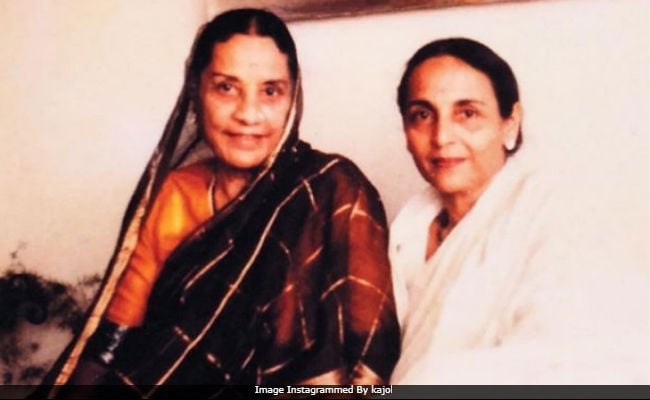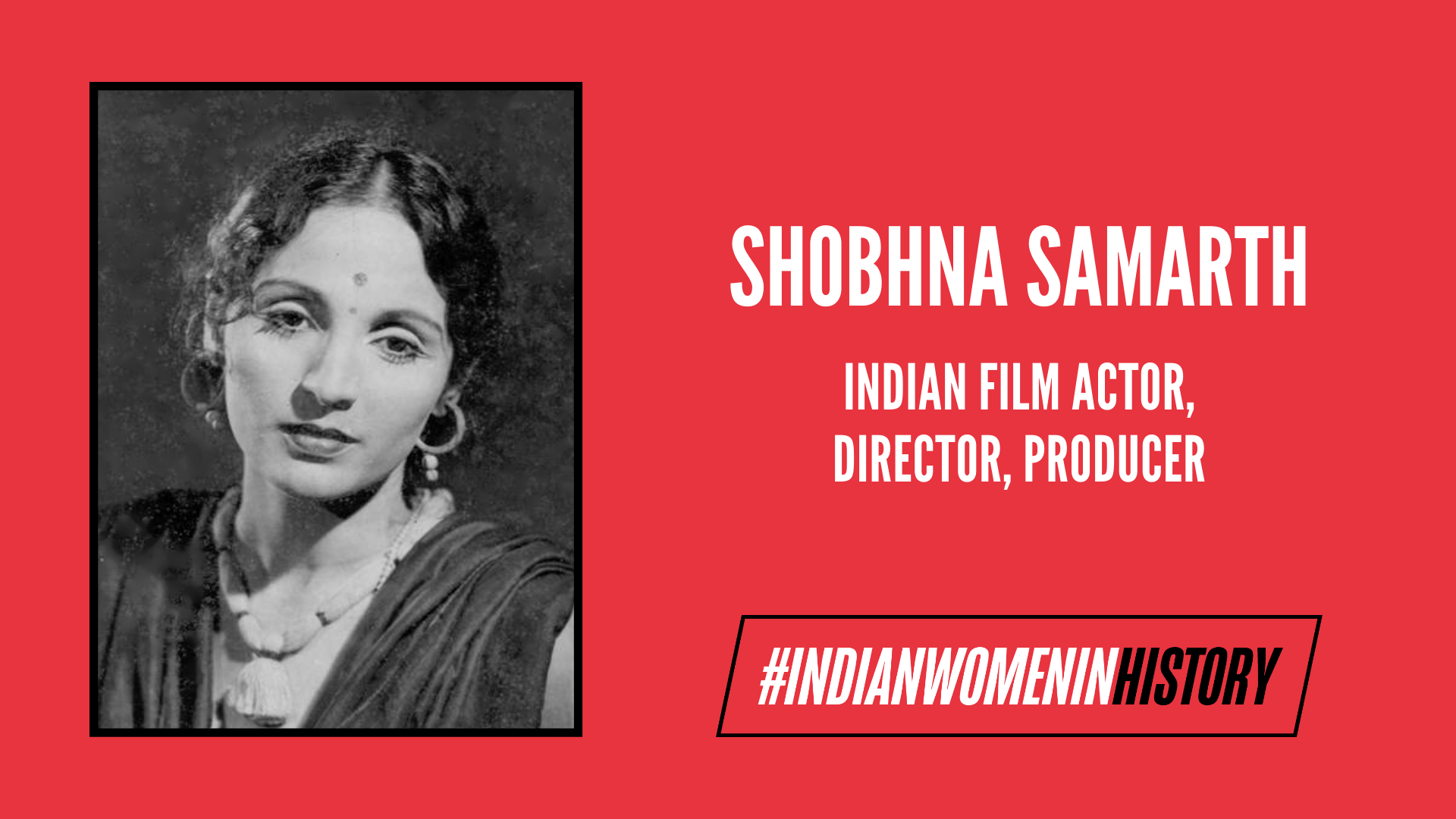Shobhna Samarth was an Indian actor, director and producer. Her life was challenging as she chose to be in the film industry, a professional avenue which was extensively male dominated and mostly continues to be, even in our times. She carved a niche for herself as an actor and rose to fame after working in the famous movie Ram Rajya (1943) in which she played the role of Sita. She was active in her career in the 1950s when acting was a taboo, especially for women from elite, dominant social classes.

Shobhna Samarth was born on 17th November 1916 as Saroj Shilotri to Rattanbai Shilotri and Prabhakar Shilotri in Bombay, British India. Her father was a prominent banker who owned the Shilotri Bank in Bombay. Her mother Rattanbai acted in a Marathi movie Swarajyachya Seemewar (Frontiers of Freedom) in 1936.
In 1931, her family shifted to Bangalore because after her father’s business suffered losses. In Bangalore, she completed her schooling at Baldwin Girls High School. Her father conducted private tuitions and her mother taught in a Marathi school to support the family financially.
Her father passed away at the end of that year. and Shobhna shifted to Bombay with her mother to live with her maternal uncle. Back in Bombay, life was difficult for her. She went to a convent school but couldn’t complete her matriculation as she had already started working in films by then. Her uncle opposed her choice to work in films citing that if she worked in films, nobody would marry her. Thereafter, Shobhna and her mother moved out of her uncle’s house.
Back in those times, the industry wasn’t known by the name of Bollywood. It was still Hindi cinema industry in the making. Shobhna Samarth entered the industry in its initial phase where a woman’s role in a film was either performed by a sex worker or men who dressed up as women. Moreover, this profession was not highly paid or respected, neither were the women who pursued it. Shobhna Samarth challenged these moral codes and continued her career in acting

She pursued her acting career while also conducting private tuitions to sustain financially. It was during this time that she met Kumarsen Samarth. He was a filmmaker who had studied cinematography from Germany and had just returned to India. He was an aspiring film maker and Shobhna married him on the condition that she would be allowed to continue her acting career. It was after her marriage that she was publicly known by the name Shobhna Samarth, as opposed to Saroj Shilotri, her official name.
Career in films
Back in those times, the industry wasn’t known by the name of Bollywood. It was still Hindi cinema industry in the making. Shobhna Samarth entered the industry in its initial phase where a woman’s role in a film was either performed by a sex worker or men who dressed up as women. Moreover, this profession was not highly paid or respected, neither were the women who pursued it.
Shobhna Samarth challenged these moral codes and continued her career in acting. Her first film was Nigah-e-Nafrat (1935), for Kolhapur Cinetone which was unsuccessful, but she received critical acclaim for her role. The film was made in Urdu and Marathi.
A few years later, she joined Sagar Movietone, and acted in Kokila (1937) and Do Diwane (1936). She then joined General Films and acted in Nirala Hindustan (Industrial India), as well as Pati Patni (1939). The same year, she joined Hindustan Cinetone and worked in four major films: Kaun Kisika (1939), Saubhagya (1940), Apni Nagariya (1940), and Ghar Javai (1940), of which her husband, Kumarsen Samarth, directed the last one. These films did very well commercially.
Also read: Nasreen Mohamedi: The First Female Abstract Artist Of India | #IndianWomenInHistory

Her career trajectory reached its peak after the release of the film Bharat Milap (1942), in which she played the role of Sita from the epic Ramayana. She did the same role in her next movie Ram Rajya (1943), a film based on the life story of Ram, which was also successful.
It was the only movie on Ram that Mahatma Gandhi watched in his lifetime, and a private screening was arranged for him. The role of Sita in mythological movies gained her accolades and made her a star. She had enormous fan following among the masses to the extent that the images of her as Sita and her co-star Prem Adib as Ram were used in comic books, calendars, paintings, and posters. People worshipped her by showering flowers and coins when she appeared on the screen.
She went on to perform similar roles in movies like Mahasati Anasuya (The Venerable Anasuya) (1943), Urvashi (1946) and more. She acted in more than 50 films in her lifetime.
Personal life
She married Kumarsen Samarth and the couple had four children; three daughters – Nutan, Tanuja, Chatura and a son – Jaideep. Nutan and Tanuja joined the profession of acting, whereas Chatura became an artist. Nutan and Shobhna had a strained relationship for over two decades. The duo reconciled towards the last days of Nutan’s life when she was diagnosed with cancer. It was after Nutan’s death that Shobhna quit acting.
Dwelling in times when cinema was a budding industry which was largely not accepting of female presence, Shobhna Samarth established an identity as a successful actor, director and producer. She did not fear the societal norms that sought to limit women. She was bold enough to chase and fulfil her dreams
Apart from Shobhna’s daughters Tanuja and Nutan, her grandchildren have also established themselves successfully in the film industry. Kajol, Tanisha Mukherjee and Mohnish Bahl, are her grandchildren and renowned actors.
Shobhna eventually separated amicably from her husband Kumarsen Samarth. Later on, she had an intimate connection with Motilal Rajvansh, an accomplished actor of those times. In one of the interviews, she said, “It was a wonderful relationship. He had a flying license, hired a plane and flew over my cottage, throwing stones with letters tied to them saying ‘I love you“, Shobhna Samarth recalls.
Director, producer, actor: Contributions to cinema
After acting as a lead actress in more than 50 films, she eventually became a producer and set up Shobhna Films. She directed two movies: Hamari Beti (1950) and Chhabili (1960) in which she launched her daughters Nutan and Tanuja.
Dwelling in times when cinema was a budding industry which was largely not accepting of female presence, Shobhna Samarth established an identity as a successful actor, director and producer. She did not fear the societal norms that sought to limit women. She was bold enough to chase and fulfil her dreams.
Her work in cinema was recognised, and she was honoured with the Filmfare Special Award for her contribution to arts. In later stages of life, she was diagnosed with cancer and she passed away on 9th February, 2000 in Pune, Maharashtra.
Also read: Outside Of The Virgin-Whore Dichotomy: Indian Cinema and Women’s Sexual Desire
About the author(s)
Dimple has a keen interest in history, cinema, and cultural studies, which fuels her curiosity. With an exploratory attitude towards life, she enjoys engaging in thoughtful conversations over a warm cup of tea.




